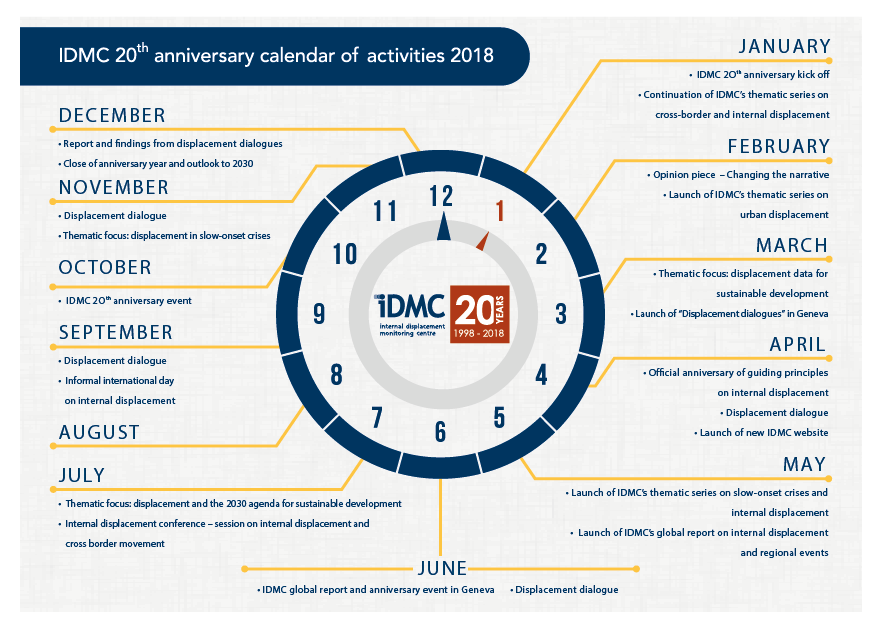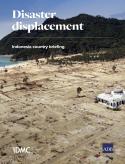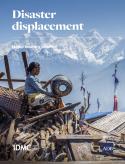Dear partners, colleagues and friends,
I would like to wish you all a very happy New Year 2018, and much personal and professional success, happiness and good health.
This year marks the 20th anniversary of the adoption of the UN Guiding Principles on Internal Displacement, and of IDMC itself. Twenty years ago, states committed to preventing armed conflict, violence, disasters and human rights violations from displacing people inside their own country, and to providing protection and assistance to them when they did. Since then, internal displacement has been recognised as an issue of global concern, and the plight, needs and vulnerabilities of internally displaced people (IDPs) have been systematically documented and reported on.
In 2017, the world experienced some of the highest rates of violence and internal displacement. These were driven by political instability, complex humanitarian emergencies, failed peace agreements, unsustainable refugee returns, urban warfare dynamics, extreme weather and disasters. Well over one million people were displaced across the eastern provinces of the Democratic Republic of the Congo during the year, fleeing armed attacks and seeking shelter wherever they could, often with no assistance. Armed violence continued to force unacceptably large numbers of people to flee across the Central African Republic, South Sudan, Nigeria, Syria, Iraq and Afghanistan. Yemen’s catastrophic humanitarian situation left the country’s two million IDPs with no access to basic services, severely malnourished and at high risk of famine. The world’s attention was also drawn in 2017 to the Caribbean and South Asia, where violent storms, floods and hurricanes swept across entire communities and left critical infrastructure destroyed and millions of people homeless.
These human tragedies give us few reasons to celebrate.
Nevertheless, at IDMC we start the new year with renewed energy and determination. We commit to elevating the issue of internal displacement within the debates on displacement and migration that have dominated the post-2015 global policy agenda and that have, to date, excluded the tens of millions of people who live in displacement within the borders of their own countries and receive little political attention or support. We argue that the exclusion of internal displacement from these conversations will come at great cost to future peace, development and security, and that it is time to refocus the world’s attention to the most vulnerable and neglected.
If 2018 is to be the year in which we see real change for IDPs, we need to think and talk about internal displacement differently. We must consider it a human rights issue, but also focus on the critical and often neglected political and development dimensions of the phenomenon. Ignoring its longer-term causes and its future impact on individuals, communities and national economies will lead to short-sighted policies and slow progress towards the achievement of national and global development goals. Beyond a moral or legal obligation, it is in the interest of national governments to invest more in preventing and finding lasting solutions to displacement.
Monitoring internal displacement in the future will need to be about more than just numbers. Building on the research we have done in the past, we will have to systematically assess which investments truly address the drivers of displacement, what can be done to mitigate its impacts and how to solve practical problems faced by the displaced and by local and national authorities. For this, solid research into the political, social, economic and environmental dimensions of displacement, and a good understanding of how these factors inter-connect and determine different levels of vulnerability, will be needed. This research will have to be comparative across contexts, draw from lessons about what works and what does not, and showcase effective and innovative solutions.
For this research to be translated into effective policy, we will need to actively involve governments and local actors from countries affected by internal displacement. Sustainable solutions to displacement need to be inclusive, locally driven, anchored in countries’ realities, and owned by governments. We will need to work hand-in-hand with these governments to ensure internal displacement becomes an integral part of their planning, and that collective outcomes are achieved by multiple stakeholders reaching across different political and institutional mandates, timeframes and budgets.
IDMC commits to working towards all these objectives in the coming years. We will prioritise building partnerships with governments, NGOs, UN agencies and academic bodies to monitor, analyse and report on internal displacement. We will offer our services and expertise to inform policy-making, and provide thought leadership in framing the issue and creating a global dialogue around it. We will build the case, finally, for mobilising more political will and financial investment, in order to definitively end the displacement of millions worldwide. This will require challenging ourselves, our mandates and our ways of working. This will mean stepping out of our comfort zone, trying out new approaches and daring to embark on a new path altogether.
This process will have to be a multi-stakeholder, multi-year one.
The process starts today.
We invite you, our partners, collaborators and supporters, to join forces with us and push the boundaries of our understanding and commitment. Our calendar of events presents some of our key activities in the coming months, and our website will feature regular updates, analysis and opinion pieces.
We look forward to working with you, and wish you again all the best for 2018.
Sincerely,
Alexandra Bilak
Director, Internal Displacement Monitoring Centre (IDMC)





